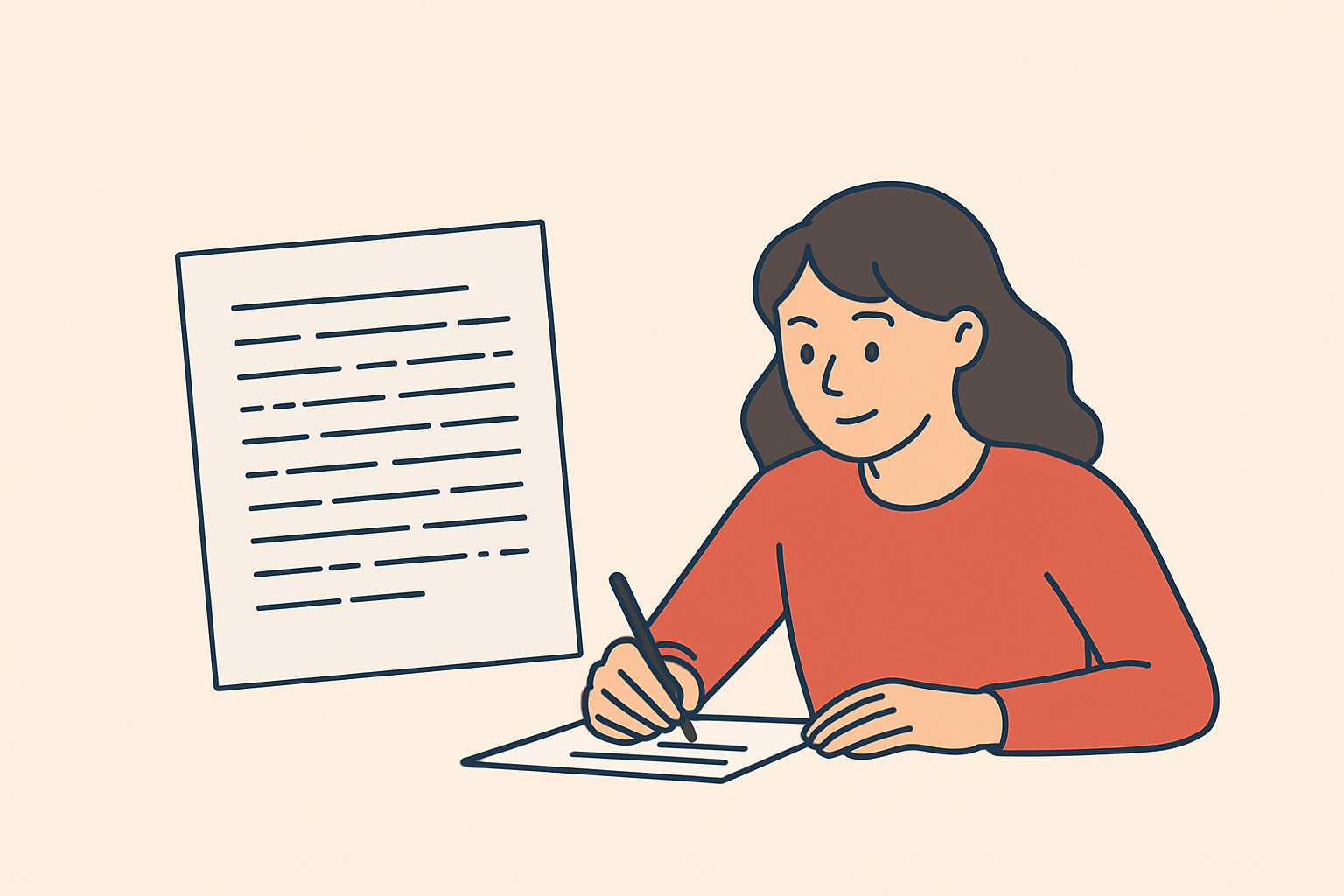Passing the C‑Test — A Guide for Studienkolleg Applicants
Published on August 14, 2025 (Updated on: August 14, 2025) by Maria

TL;DR
The C‑Test is a standardized gap‑fill test that measures language competence in context. Focus your preparation on grammar, vocabulary, and reading fluency; practice real C‑tests under timed conditions; and use smart test strategies (read first, then fill gaps; do easy gaps first; keep time buffers).
What is a C‑Test (Lückentest)?
The C‑Test is a special type of cloze test: in several short continuous texts, parts of words (usually the second half) are systematically removed. Your task is to restore the missing parts so that grammar and meaning are correct.
Why this format? It quickly and reliably measures language ability in realistic contexts — not only vocabulary but also syntax, morphology, and collocations.
Structure & test characteristics
- Text length: Usually 2–5 short passages with multiple gaps each.
- Gap type: Partial words (e.g., “Studen—” → “Studenten”).
- Difficulty: Selection procedures such as Studienkollegs typically require a higher level (often B2+).
- Timing: Time is limited — fast reading and decision‑making are essential.
- Scoring: Each correct gap counts; incorrect answers usually score zero (scoring rules may vary by provider).
Practical preparation — strategy & study plan
Effective preparation combines four building blocks: grammar, vocabulary & collocations, reading fluency, and targeted C‑test practice.
6‑week plan (recommended)
Weeks 1–2 — Foundations
- 1 h/day: Focus on grammar (articles, cases, word order, tenses, subordinate clauses).
- Vocabulary work: thematic lists + collocations (e.g., “to take an exam” / eine Prüfung ablegen).
Weeks 3–4 — Reading practice
- 1 h/day: Read short texts and infer unknown words from context.
- Practice word families and synonyms.
Week 5 — C‑test training
- Solve 10-20 C‑test sections daily; analyze mistakes systematically.
Week 6 — Simulation
- Take at least 20 full tests under real time pressure; keep an error log.
Concrete study resources
- C‑test books / online simulators
- Anki (SRS) for collocations
- Short texts: news articles, university pages, forums
- Writing practice: short summaries
Techniques for solving C‑tests
- Read the whole passage first, then fill gaps. Context is more helpful than guessing isolated words.
- Pay attention to word form: case, number, tense, and separable prefixes.
- Prioritize function words: many gaps involve articles, prepositions, and auxiliary verbs.
- Mark uncertainties: if time is tight, leave them and return later.
- Guess with a grammar check: when two words fit, choose the grammatically correct option.
Test‑day tactics
Before the test:
- Get enough sleep and have a light meal; check materials (pen, ID).
- Arrive 10–15 minutes early to relax and do a breathing exercise.
During the test:
- Skim the texts for 1–2 minutes.
- Do the easy gaps first to secure quick points.
- Mark hard gaps and come back to them later.
- Reserve time at the end for proofreading (spelling, endings).
Common mistakes to avoid:
- Wrong verb forms, incorrect case, mishandling separable verbs, and errors in noun capitalization.
Practice examples (to try right away)
Short example A:
Am Mon— früh stand die Stu— auf, zog sich an und ging zur Vo—. Die Vor— begann pünktlich.
Sample answers: Montag, Studentin, Vorlesung, Vorlesung
Short example B:
Die Auf— im Kurs war sehr schwie—, doch durch ge— Arbeit konnte sie die Auf— lö—.
Sample answers: Aufgabe, schwierig, geleistete/gemachte (context dependent), Aufgaben, lösen
Note: Practice with authentic C‑tests — these are only illustrative fragments.
Printable checklist before the test
- Enough sleep the night before the exam
- Breakfast / light meal
- Pens and ID prepared
- At least one timed practice test completed
- Error log from practice tests created
- 5‑minute breathing exercise planned
FAQ — short answers
How often should I practice? Daily practice for 60 minutes is more effective than occasional marathon sessions.
Is vocabulary drilling enough? Not really — without grammar and context training you won’t be able to place many gaps correctly.
What proficiency level is required? Studienkollegs typically expect B2 or higher; check the specific requirements of the Studienkolleg you’re applying to.
Further resources
Here are selected, reliable links to interactive exercises, PDF examples, and additional preparation material. Use them for focused C‑test training and timed simulations.
- C‑Test (Demo & Online Practice)
- University of Münster — C‑Test (PDF: Guidelines & Examples) — Comprehensive PDF with explanations and sample C‑tests
- Deutschlernerblog — Collection: C‑Test models online and as PDFs — Overview with links to several C‑tests and worksheets
- University of Hamburg — DaF‑Check (C‑Test information) — Information and examples for the C‑test as a placement test
- University of Rostock — C‑Test (placement test info) — Descriptions of task formats and sample tests
Conclusion
Systematic preparation (grammar + vocabulary + simulations) combined with smart test strategies leads to noticeably better results. Practice regularly, analyze mistakes deliberately, and stay calm and structured on test day.
Glossary
C‑Test / Cloze test (partial‑gap variant) — A standardized gap‑fill format in which parts of words are systematically deleted in short passages; used to assess language ability in context.
Gap — The position in a text where a whole word or a part of a word is missing and must be completed.
Word stem — The base form of a word to which endings or prefixes are added.
Separable verb — A verb in German that can split in certain sentence structures (e.g., aufstehen → “steht … auf”).
Case (Kasus) — Grammatical cases (nominative, genitive, dative, accusative) that determine the form of articles and pronouns.
Article — Definite or indefinite determiners used with nouns (e.g., the, a/an / der, die, das, ein).
Preposition — A word that links nouns/pronouns to other words and often determines case (e.g., with, for, at / mit, für, bei).
Collocation — Words that commonly occur together (e.g., “to take an exam” / eine Prüfung ablegen).
Reading fluency — The ability to read and comprehend text quickly; important for working under time pressure in C‑tests.
Test simulation / practice test — A timed practice session that mirrors exam conditions for preparation and error analysis.
Error log — A record of repeated mistakes used to target practice.
Function word — Words with grammatical function (e.g., articles, prepositions, auxiliary verbs) that frequently appear as gaps in C‑tests.
Share this article
More Articles from our Blog

Choosing the Right Studienkolleg in Germany - Your Gateway to University Success.
June 29, 2025
Learn how to choose the right Studienkolleg in Germany – From course types to public vs. private colleges and the external university entrance exam. A must-read for international students!

Study in Germany – Your Guide for International Students
June 29, 2025
All you need to know about studying in Germany: application, admission, visa, living costs, student jobs, scholarships, and more.

What is a Studienkolleg? A guide for international students.
June 28, 2025
Learn what a Studienkolleg is, who can apply, and how international students can qualify to study at a university in Germany.